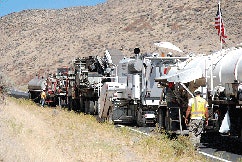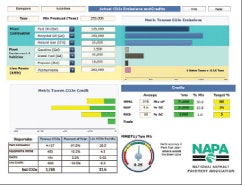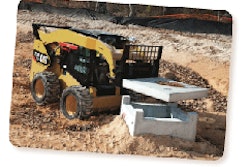Pre-Measure Your Carbon Footprint
Calculators help predict the environmental impact of roadbuilding projects
By Tom Kuennen, Contributing Editor
New tools keep appearing to help the highway, road and bridge community determine the environmental impact of the infrastructure they design and build.
 Cold-in-place recycling of failed pavements optimizes use of in-place materials, relieving pressure on virgin aggregate extraction sites, on landfills, and greatly reduces truck trips with benefits to air quality, congestion, noise and reduced resource consumption.
Cold-in-place recycling of failed pavements optimizes use of in-place materials, relieving pressure on virgin aggregate extraction sites, on landfills, and greatly reduces truck trips with benefits to air quality, congestion, noise and reduced resource consumption.Last month we looked at the proliferation of environmental certification programs available for highways (see Roadway Environmental Ratings: What’s Best for Your Agency?, November 2012, pp. 21-27). But in addition to these guidelines for a holistic summation of the environmental sustainability of a project, a plethora of environmental calculators now exist for a road builder to use in determining project sustainability in advance of construction.
These software-based eco-calculators allow an array of variables or “inputs” about a project – such as dimensions, materials, quantities, haul distances and equipment – and kick out data such as quantities of carbon dioxide emitted in construction or over the life of a project, other emissions and more. These data can provide a user with multiple paths to a sustainable project. In doing so a planner gets hard data projections he or she can use to justify or defend a project against those who would oppose it.
These calculators can be used in advance by an agency to establish project fundamentals, by a contractor to pose environmental alternatives that will favor his capabilities, or by consulting engineers to assist their agency clients.
For example, at the October semiannual meeting of the Asphalt Recycling & Reclaiming Association, Donald M. Matthews, P.E., of Pavement Recycling Systems in Riverside, Calif., said contractors can use the value engineering process – using environmental sustainability calculations – to suggest to clients that an alternate (in this case, cold-in-place recycling) could save time and money for a client.
“Use the calculations to suggest and prove that an alternative method will save an agency money, while providing them with an equal or better product,” Matthews says. “Sustainability calculators are valuable ways of showing even more benefit to an agency as agency personnel will get the pat on the back they deserve.”
Not surprisingly, eco-calculators first appeared in Europe, but now are making their way into North America. Some are proprietary and were developed by corporations for internal use; some are public domain, developed by government agencies; and some may promote one outcome or the other, depending on which business or national association is promoting it.
And contractors and agencies have been doing this type of evaluation in recent years without formal calculators. Using spreadsheets and their own knowledge, they’ve been able to informally determine the environmental impact of their projects.
 National Asphalt Pavement Association’s Greenhouse Gas Calculator is an online tool that determines GHG emissions at the plant.
National Asphalt Pavement Association’s Greenhouse Gas Calculator is an online tool that determines GHG emissions at the plant.For example, in 2006, just by simple calculation that incorporated materials, quantities and truck trip inputs, Caltrans’ Joe Peterson, P.E. – now statewide chief of the Office of Roadway Materials Testing – was able to determine the benefits of an in-place recycling of busy I-80 through cities and countryside on the western slope of the Sierra Nevada.
“They saved approximately 112,200 short tons of aggregate, 2,860 tons of bitumen and 9,200 truck trips,” Robertson says in a presentation. “That’s an incredible number of truck trips, and that doesn’t include all the auxiliary equipment that would have been moving in and out of the work zone.”
He also calculated emissions benefits. “Because the project was in an urban environment, the 15,800 pounds of NOx that was not put in the environment made a lot of the people in the area a lot happier,” he says.
“That is because our mountain-and-valley areas are subject to inversion layers in the atmosphere, which trap all the smog down low. Anything they can do on a construction project to lessen that impact is a benefit to everyone.”
But today’s tools permit much greater detail in sustainability benefit reporting. Here are a few of them.
PaLATE Within Greenroads
One useful eco-calculator is found within the Greenroads certification system. As described last month, the Greenroads Rating System is a certification process for sustainable roadway and bridge construction projects, not unlike the Leadership in Environmental Excellence in Design (LEED) system for certifying buildings and developments.
Greenroads rates a project’s sustainable elements in seven categories: Project Requirements, Environment and Water, Access and Equity, Construction Activities, Materials and Resources, Pavement Technologies and Custom Credits. Accumulated points will position a project for one of four levels of certification: Bronze, Silver, Gold and Evergreen.
Under Greenroads, points may be accumulated by use of the environmental sustainability calculator PaLATE v2.2 as modified for Greenroads, or an approved equivalent. The idea is to incorporate – in advance – energy and emissions information into decision-making for pavement design alternatives.
Emissions of greenhouse gases are typically expressed in a common metric so that their impacts can be directly compared, as some gases are more potent (i.e., have a [presumed] higher global warming potential) than others, according to the Environmental Protection Agency. Thus the international standard practice is to express greenhouse gases in carbon dioxide equivalents (CO2e).
With PaLATE 2.2, for points to be obtained, a lifecycle inventory for the final pavement design alternative for the project should report total energy use and global warming potential in CO2e.
Inputs include:
• Total weight and types of virgin materials. This includes aggregates, binders, base materials and structures, according to Greenroads. These amounts can be design estimates or constructed totals.
• Total weight and types of recycled materials. PaLATE v2.2 models emissions and energy for several types of materials
• Expected transportation distances for all materials. This means distances from source to production as well as from production to site. Transportation of waste to disposal is also included.
• Expected construction vehicle types. These include, but are not limited to, pavers, mixers, hauling vehicles, excavators, rollers and finishing equipment. Obviously use of the new mobile equipment meeting Tier 4-interim emissions guidelines would be a plus.
• Estimated design life. This should reflect the same input data as used in Greenroads Lifecycle Cost Analysis section.
• Scheduled years and expected type of maintenance. Likewise, Greenroads suggests use of the same input data as used in its Lifecycle Cost Analysis, and meet project specs provided for its pavement and site maintenance plans.
FHWA’s INVEST Now a Reality
On October 10, the Federal Highway Administration’s INVEST sustainable pavements rating system was introduced. Not a calculator per se, it’s a totally free, voluntary, web-based tool for assessing the environmental sustainability over the lifecycle of a transportation project or program, including system and project planning, through design and construction, to operations and maintenance.
 Opening screens of detailed National Ready Mixed Concrete Carbon Calculator, a spreadsheet that enables calculations of carbon footprint of concrete products and projects.
Opening screens of detailed National Ready Mixed Concrete Carbon Calculator, a spreadsheet that enables calculations of carbon footprint of concrete products and projects.INVEST is intended to permit agencies to assess their own transportation plans, projects and programs, and help them make more informed decisions with limited resources to balance what FHWA calls economic, social and environmental factors.
Goals of INVEST are to support the U.S. DOT’s aims for livability and sustainable transportation, increase the body of knowledge regarding sustainability aspects of both asphalt and concrete materials in pavement design, construction, preservation and maintenance, and to boost use of sustainable technologies and practices in pavement design, construction, preservation and maintenance, FHWA says.
More information – and the program – may be downloaded at www.sustainablehighways.org
NAPA’s Greenhouse Gas Calculator
The National Asphalt Pavement Association has stepped into the fray with its Greenhouse Gas Calculator for pavements, revised in 2012 and currently under beta testing.
This online tool calculates greenhouse gas emissions related to asphalt pavement manufacturing in a gate-to-gate analysis. “The user-friendly interface provides drop-down lists of typical fuels that are linked to greenhouse gas emission factors, expressed as carbon dioxide equivalents (CO2e), the universal measure of greenhouse gas emissions,” NAPA says.
The calculator provides inputs for three separate fuels used by a rotary dryer, plus three additional fuels used inside the facility by equipment, including vehicles. “A final category addresses CO2e attributed to electrical use, with unique factors for each state,” NAPA says. “Fuel used for onsite power generation should also be included. Generally, the more fuel combusted or burned, the more CO2-equivalent gases [that] are emitted.”
 FHWA’s INVEST – released in October 2012 – was tested for two years prior to launch, but the final product is radically different from the one used in beta and pilot program testing.
FHWA’s INVEST – released in October 2012 – was tested for two years prior to launch, but the final product is radically different from the one used in beta and pilot program testing.The beta update adds emission offset credits for those fuels and activities that either reduce the amount of CO2e released, or that sequester CO2. Credits are calculated for plant-based bio-fuels, transportation credits for waste derived fuels like recycled fuel oil, and cradle to gate credits for recycled raw materials like RAP and shingles. Credits are also calculated for reducing mix temperatures using warm mix asphalt technologies, based on user defined mix temperature.
To learn more, or to use the calculator or view an online webinar on its use, visit http://www.asphaltpavement.org/ghgc
In 2009 NAPA published an environmental sustainability report on asphalt, the first ever of its kind for the asphalt industry. Titled Black and Green: Sustainable Asphalt, Now and Tomorrow, it highlights the ways in which the asphalt industry’s everyday practices address climate change, improve air quality and water quality, provide green jobs, and reduce the carbon footprint of pavements. This 12-page report can be downloaded at http://www.asphaltpavement.org/images/stories/sustainability_report_2009.pdf
Britain’s asPECT
In Great Britain, a calculator to measure the lifecycle greenhouse gas emissions or “carbon footprint” of asphalt used in highways has been developed and maintained by TRL, the Transport Research Laboratory. This program – dubbed asPECT, for Asphalt Pavement Embodied Carbon Tool – was produced as a result of a 2008-11 collaborative research effort of the Highways Agency, Mineral Products Association, Refined Bitumen Association and TRL Limited.
asPECT provides a methodology to calculate the whole life contribution of highway products to climate change. At its core is the calculator, a downloadable spreadsheet-based product that guides the user through the program’s methodology and makes the necessary calculations using up-to-date emissions factors on the user’s behalf. Learn more at www.sustainabilityofhighways.org.uk
Concrete’s Carbon Calculator
The National Ready Mixed Concrete Association has made available its NRMCA Sustainable Concrete Carbon Calculator. It will quickly determine two environmental impact measures to use to benchmark annual RMC production, Global Warming Potential, and Primary Energy Consumption. Global Warming Potential is reported in metric tonnes CO2e and short tons CO2e, and is a reference measure to report the amount of greenhouse gases produced in extraction, processing, transportation, construction and even disposal of material.
Primary Energy Consumption is reported in mega-joules and millions of Btus, and includes all primary energy consumed, directly and indirectly, to transform and transport raw materials into concrete products and buildings, NRMCA says.
It includes inherent energy in raw or feedstock materials that are also used as common energy sources, and also captures pre-combustion (indirect) energy use associated with processing, transporting, converting and delivering fuel and energy.
A plant emissions calculator is available as well. To learn more or to use the calculator visit www.rmc-foundation.org/Env_Health_Safety_Track.htm
Last December the National Concrete Pavement Technology Center at Iowa State University released Sustainable Concrete Pavements: A Manual of Practice.
This guide provides a clear, concise and cohesive discussion of pavement sustainability concepts and of recommended practices for maximizing the sustainability of concrete pavements. Download it at www.cptechcenter.org/publications/Sustainable_Concrete_Pavement_508.pdf
Bridge Project Evaluated
The PaLATE program was used in evaluating a bridge project last year, as described by Jeralee L. Anderson, P.E., and Craig Weiland, Department of Civil and Environmental Engineering, University of Washington, in their 2012 Transportation Research Board paper, Energy and Carbon Footprint of a Single Span Concrete Bridge.
For this purpose, lifecycle assessment (LCA) – a systematic way to quantify environmental impacts for all life stages of a project – was used to inform project decision making and complement results of other decision-making tools, such as cost projections determined through bridge lifecycle cost analysis.
“PaLATE v2.2 [as modified for Greenpave] is a streamlined tool for lifecycle assessment that is non-proprietary,” Anderson and Weiland say. “It does not include vehicle energy and emissions from users of the final structure, but does address demolition, construction, production of materials and transport of materials.”
The results of this study show that LCA can be completed on bridge projects using an easily accessible and free tool and standard bridge design and construction documents, the authors conclude. “As expected, materials production and transportation are the most significant contribution to thelifetime energy consumption and CO2e emissions,” they say.
Granite’s Corporate Program
Corporations develop their own eco-calculators. Foremost among them is California-based Granite Construction whose Granite Environmental Management System (GEMS) to provide a consistent and reliable framework for managing environmental responsibilities.
GEMS is central to the firm’s environmental management efforts. “GEMS is a system of business processes that supports Granite’s environmental objectives and policies, and ensures that our actions align with our environmental vision and strategy, core values, and environmental affairs policy,” the big contractor says.
Other tools include a comprehensive environmental and land management software system, and an ongoing self-evaluation of operations. “Our strategy focuses our efforts on our environmental management procedures and systems, recycling of construction materials, energy conservation and land stewardship.”
Granite recently joined the Sustainability Infrastructure Advisory Board (SIAB) at Harvard University.
This board – with other members such as the Louis Berger Group, HNTB and Stantec, provides input to the Institute for Sustainable Infrastructure (ISI) there, developers of the new infrastructure rating system, Envision, developed to help designers, builders and infrastructure owners build and direct infrastructure projects toward increasing levels of sustainability.
More information on Envision can be found in last month’s RoadScience article.
Landmark Colas Study
Paving the way for these calculators was a landmark 2003 report. Environmental Road of the Future: Life Cycle Analysis, Energy Consumption and Greenhouse Gas Emissions, by M. Chappat and J. Bilal – was released by the Colas Group and is an in-depth analysis of energy consumption and GHG emissions of more than 20 different paving product types by ton of material placed.
Chappat and Bilal show that portland cement concrete (PCC) paving materials and processes demand the most energy, followed by hot mix asphalt (HMA) paving. The report also showed that cold-in-place (CIP) recycling is the least energy-intensive process.
“A comprehensive and realistic measure of energy use and GHG emissions of a specific type of roadwork begins at the extraction of raw materials from the earth, including all intermediate steps, such as transport, refining, manufacturing, mixing and placement,” says Jim Chehovits, P.E., vice president, operations, Crafco, Inc., and Larry Galehouse, P.E., director, National Center for Pavement Preservation. “These energy input and emissions data then can be extended via an annualized life extension basis.”
Energy consumption for aggregate production includes quarrying, hauling, crushing and screening. Chappat and Bilal demonstrate that energy consumption for aggregate production ranges from 25,850 to 34,470 Btu/t, and GHG emissions range from 5 to 20 pounds CO2/t.
Energy consumption for asphalt binder production includes crude oil extraction, transport and refining. Energy consumption for asphalt binders has been determined to be 4.2 mm Btu/t, and GHG emissions are 570 pounds CO2/t.
Download the report at www.colas.com/FRONT/COLAS/upload/com/pdf/route-future-english.pdf














